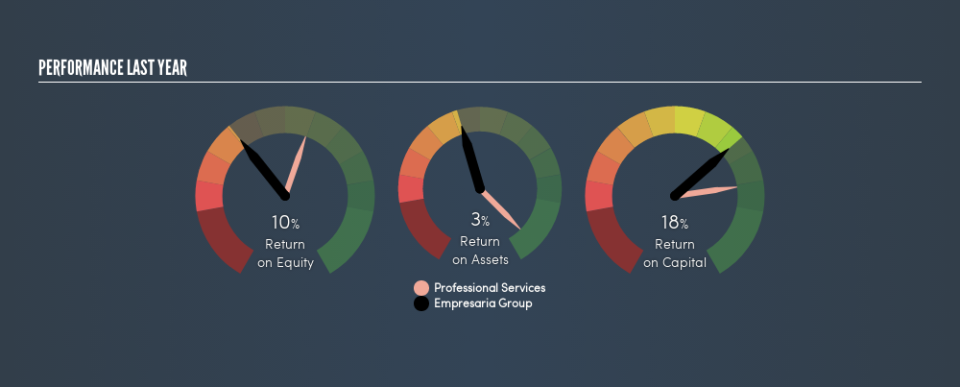Is Empresaria Group plc (LON:EMR) Creating Value For Shareholders?

Today we’ll look at Empresaria Group plc (LON:EMR) and reflect on its potential as an investment. Specifically, we’re going to calculate its Return On Capital Employed (ROCE), in the hopes of getting some insight into the business.
Firstly, we’ll go over how we calculate ROCE. Then we’ll compare its ROCE to similar companies. Last but not least, we’ll look at what impact its current liabilities have on its ROCE.
What is Return On Capital Employed (ROCE)?
ROCE is a measure of a company’s yearly pre-tax profit (its return), relative to the capital employed in the business. Generally speaking a higher ROCE is better. In brief, it is a useful tool, but it is not without drawbacks. Renowned investment researcher Michael Mauboussin has suggested that a high ROCE can indicate that ‘one dollar invested in the company generates value of more than one dollar’.
So, How Do We Calculate ROCE?
Analysts use this formula to calculate return on capital employed:
Return on Capital Employed = Earnings Before Interest and Tax (EBIT) ÷ (Total Assets – Current Liabilities)
Or for Empresaria Group:
0.18 = UK£9.9m ÷ (UK£137m – UK£81m) (Based on the trailing twelve months to June 2018.)
So, Empresaria Group has an ROCE of 18%.
View our latest analysis for Empresaria Group
Does Empresaria Group Have A Good ROCE?
One way to assess ROCE is to compare similar companies. We can see Empresaria Group’s ROCE is around the 21% average reported by the Professional Services industry. Regardless of where Empresaria Group sits next to its industry, its ROCE in absolute terms appears satisfactory, and this company could be worth a closer look.
It is important to remember that ROCE shows past performance, and is not necessarily predictive. Companies in cyclical industries can be difficult to understand using ROCE, as returns typically look high during boom times, and low during busts. ROCE is only a point-in-time measure. Future performance is what matters, and you can see analyst predictions in our free report on analyst forecasts for the company.
What Are Current Liabilities, And How Do They Affect Empresaria Group’s ROCE?
Short term (or current) liabilities, are things like supplier invoices, overdrafts, or tax bills that need to be paid within 12 months. Due to the way ROCE is calculated, a high level of current liabilities makes a company look as though it has less capital employed, and thus can (sometimes unfairly) boost the ROCE. To counteract this, we check if a company has high current liabilities, relative to its total assets.
Empresaria Group has total liabilities of UK£81m and total assets of UK£137m. Therefore its current liabilities are equivalent to approximately 59% of its total assets. This is admittedly a high level of current liabilities, improving ROCE substantially.
What We Can Learn From Empresaria Group’s ROCE
The ROCE would not look as appealing if the company had fewer current liabilities. Of course, you might find a fantastic investment by looking at a few good candidates. So take a peek at this free list of companies with modest (or no) debt, trading on a P/E below 20.
If you like to buy stocks alongside management, then you might just love this free list of companies. (Hint: insiders have been buying them).
We aim to bring you long-term focused research analysis driven by fundamental data. Note that our analysis may not factor in the latest price-sensitive company announcements or qualitative material.
If you spot an error that warrants correction, please contact the editor at editorial-team@simplywallst.com. This article by Simply Wall St is general in nature. It does not constitute a recommendation to buy or sell any stock, and does not take account of your objectives, or your financial situation. Simply Wall St has no position in the stocks mentioned. Thank you for reading.

